Top 10 Kiteboarding Myths
Kiteboarding Tips
A great tip from Lisa Moss.
Lisa is a former employee of MACkite who now lives in Utah with her husband Zac. Lisa has one of the best "go for it" attitudes we have ever seen.
Tip #9 - Top 10 Kiteboarding Myths
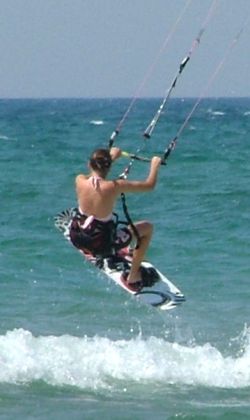 #1 You must be strong
#1 You must be strong
First of all, let me tell you that I am a 5'4" female; I weigh 100 pounds, and I have only been to a gym once in my life. Even though my arm muscle is virtually non-existent, I can still manage to kiteboard for hours straight, compared to wakeboarding where after about 10 minutes, my arms and legs feel like they're going to explode. With kiteboarding, you wear a harness so the pressure is taken off your arms, thus allowing even small people like me to kiteboard.
#2 I'm too fat / too tall / too small / too old / too young
Kites come in many sizes. If you're a smaller rider, you'll be riding a smaller kite than the average guy. Many kiteboard stores require you to weigh at least 80 pounds in order to take a lesson. If your son/daughter wants to get into kiteboarding, but they are under the weight requirement or you feel they are too young, start them out with a trainer kite. A trainer kite is a smaller version of a kiteboarding kite and is step #1 in kiteboarding. You can never spend too much time with a trainer kite.
I've seen guys in the 300-pound range kiteboarding. Basically, they're using a bigger kite and board than the average rider and they may need a bit more wind to get started.
Height doesn't matter, but if you are a petite rider, you may want to consider buying a seat harness rather than a waist harness. This will move the bar closer to your body and put the power/depower strap within better reach.
I've seen older guys in their 60s kiteboarding (and honestly, a lot of those guys can kick my butt). If you have back problems, buy a seat harness rather than a waist harness, and buy a kite that has a lot of depower (bow, SLE, or hybrid kite).
#3 Kiteboarding is very dangerous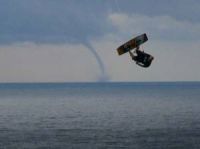 As long as you take the necessary precautions, kiteboarding is relatively safe. I say relatively, because everything in life has risk, even driving your car to the grocery store. However, if you don't know what you're doing, things can go bad, very bad. Take a lesson! When in doubt, don't go out. Never ride by yourself. Don't kite in storms or other times when the wind isn't steady and reliable. Always be ready to release the kite. And again, take a lesson (the more the better)!
As long as you take the necessary precautions, kiteboarding is relatively safe. I say relatively, because everything in life has risk, even driving your car to the grocery store. However, if you don't know what you're doing, things can go bad, very bad. Take a lesson! When in doubt, don't go out. Never ride by yourself. Don't kite in storms or other times when the wind isn't steady and reliable. Always be ready to release the kite. And again, take a lesson (the more the better)!
#4 I don't need a lesson
Just because you're a pro wakeboarder/snowboarder, etc., doesn't mean you're a good kiteboarder. You need to learn how to fly the kite. Kiteboarding is 80% kite skills, and 20% board skills. Pick up a trainer kite and spend time flying it, and then take a lesson. If you're not an expert kite flyer, you'll never get the chance to put those board skills to good use behind the kite.
Kiteboarding is very dangerous if you don't know what you're doing. Let's say you went out and bought the gear on eBay and brought it to a busy beach. You manage to get the kite set up (which you learned from the $20 video you bought), and a buddy is helping you launch the kite. The kite goes up in the air, you pull slightly on one of the sides of the bar and the kite zooms down and around with great speed and power through what is known as the power zone. The kite launches you Superman style about 50 feet downwind into a crowd of people (or headfirst into rocks). The lines of the kite come within inches of the heads of all the people downwind of you on the beach (with enough force to kill).
This is not wakeboarding, skiing, or surfing. It is more comparable to scuba diving, except if you screw up, not only are you putting yourself at risk, but also everyone on that beach. It is absolutely critical that you know what you are doing. A minimum of at least one lesson is mandatory. No exceptions.
#5 I'll take a lesson and be riding by the end of the day
I wish! Ok, each year the gear is getting better and better. Three years ago, it would take weeks to be able to learn what people now can learn in a matter of days. Even so, do not expect to be up and riding your first time (or second time for that matter). It does happen every now and then and there are ways to improve your chances. For example, spend lots and lots (did I say lots) of time with a trainer kite (practice flying one-handed, hooked in to a harness, with your eyes shut, etc.). Spend some time wakeboarding and spend a day wakeboarding or snowboarding with your opposite foot forward.
#6 Trainer kite? I don't need a trainer kite!
I remember my thoughts the first time someone recommended I buy a trainer kite before even taking my lesson. They wanted me to spend $70-$300 on a kite that is just meant to train - and it isn't even used for kiteboarding!? You gotta be kidding! How hard is it to fly a kite?
Now as a seasoned kiteboarder I completely understand and believe that buying a trainer kite is one of the smartest moves you can make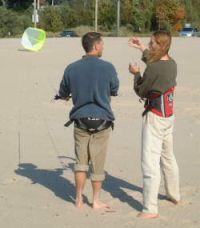 (other than taking lessons of course). You can learn so much with a trainer kite that by the time you take a lesson, you'll feel much more comfortable handling the real thing. Sure, you can skip that step and go straight to the lesson. But since you're spending $300+ for a one-day lesson, do you really want to spend the entire time learning how to fly a smaller kite? You would be much better off spending your money on a trainer kite, and once you're very proficient at it, then take a lesson. Kiteboard instructors will start you off with a trainer kite, and once they see that you have the necessary skills, they will move you onto the next step. If you can't keep a kite in the sky, don't expect to progress any further.
(other than taking lessons of course). You can learn so much with a trainer kite that by the time you take a lesson, you'll feel much more comfortable handling the real thing. Sure, you can skip that step and go straight to the lesson. But since you're spending $300+ for a one-day lesson, do you really want to spend the entire time learning how to fly a smaller kite? You would be much better off spending your money on a trainer kite, and once you're very proficient at it, then take a lesson. Kiteboard instructors will start you off with a trainer kite, and once they see that you have the necessary skills, they will move you onto the next step. If you can't keep a kite in the sky, don't expect to progress any further.
Ok. So, you know how to fly a kite - you've spent about 20 minutes flying a trainer kite, now you're ready for the lesson. Wrong! Just because you can keep the kite up in the air while standing perfectly straight and stiff, doesn't mean you're an expert kite flyer. Can you fly the kite hooked in, one handed, backwards, and with your eyes shut? If someone were to come up from behind you and knock you to the ground, can you fall while still keeping the kite in the air? These are skills that you will need to learn... fast! You can learn it the hard way, or you can learn it the easy way (with a trainer kite). It is your choice. The more time you spend with the trainer kite, the better off you'll be.
#7 Kiteboarding is expensive
Well, it is more expensive than something like tennis, for example. If you go out and buy the complete kiteboard set up (kite, bar & lines, harness, board), you're looking at around $1,800 - $2,000. Ok, that number may seem big, but let's think about this. If you want to wakeboard,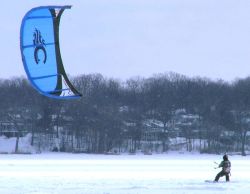 you need a boat ($40,000) plus plan on spending a good chunk of money on gas each time you go out. In the wintertime, you spend money on lift tickets each time you want to go skiing/snowboarding ($45-70 each time). Why not just strap your snowboard/skis on your feet and hold onto the kite and rip it up for free (use the same kite and harness, just add your skis/board). When you think of it that way, the $2,000 for year-round fun doesn't look so bad.
you need a boat ($40,000) plus plan on spending a good chunk of money on gas each time you go out. In the wintertime, you spend money on lift tickets each time you want to go skiing/snowboarding ($45-70 each time). Why not just strap your snowboard/skis on your feet and hold onto the kite and rip it up for free (use the same kite and harness, just add your skis/board). When you think of it that way, the $2,000 for year-round fun doesn't look so bad.
#8 Kiteboarding can only be done in the ocean
Wrong. Kiteboarding can be done in any large body of water. Heck, I've kiteboarded in a large mud pond that was only about a foot deep (not recommended). A sandy shoreline along with clean, steady wind is ideal. Open areas like the Great Lakes or oceans typically get smoother wind than inland spots like lakes and reservoirs. Kiteboarding can also be done in the wintertime (snowkiting) on open fields or frozen lakes with a snowboard or skis. And then there is kite ground boarding (KGB) where you use a landboard (think skateboard with huge wheels) with a kite; the possibilities go on and on...
#9 I have a wakeboard, all I need is a kite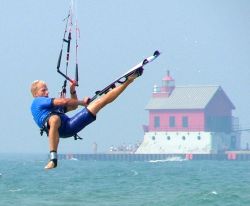 Your wakeboard is designed differently than a kiteboard. A kiteboard is much lighter, thus not needing as much power to get up on a plane. The bindings on a wakeboard are boot-like and hard to get into, compared to the easy-entry, sandal-like binding of a kiteboard. Basically, when you're in the water with the kite, you're going to want it as easy as possible to put that board on your feet while you're flying the kite (and possibly having waves smack against you). A kiteboard is designed to let you quickly and effortlessly slide your feet in (advanced riders will even take off their board and put it back on their feet in mid-air).
Your wakeboard is designed differently than a kiteboard. A kiteboard is much lighter, thus not needing as much power to get up on a plane. The bindings on a wakeboard are boot-like and hard to get into, compared to the easy-entry, sandal-like binding of a kiteboard. Basically, when you're in the water with the kite, you're going to want it as easy as possible to put that board on your feet while you're flying the kite (and possibly having waves smack against you). A kiteboard is designed to let you quickly and effortlessly slide your feet in (advanced riders will even take off their board and put it back on their feet in mid-air).
A kiteboard also has less rocker (meaning it is flatter) and is meant to be ridden on the rail (edge). A kiteboard cuts through the chop of a wave while a wakeboard bounces off it. Try to imagine wakeboarding in a choppy ocean- doesn't sound too good, does it? A kiteboard on the other hand, lets you cut right through all that chop and gives you a nice ride, thus opening up the possibility to ride basically anything. When you want to jump, you use the kite to pull you up in the air, thus being able to jump anywhere up to 35+ feet off smooth water.
#10 I found a great deal on a kite off eBay!
Oh really? Unless you are a seasoned kiteboarder and know exactly what to look for in a kite, I strongly recommend staying away from eBay when it comes to buying a kite. Have you ever noticed how every kite listed on there is "great for beginners"? Don't believe everything you're told. Just about every eBay kite that I've seen people bring to the beach makes me cringe. Many times, the kite is old (old in kiteboarding can mean anything over 2-3 years old) and may not have much in terms of the ability to depower the kite or other safety features. Remember, kiteboarding is still a new sport, and the equipment today is one hundred percent better than it was 4 years ago. Also, many times with kites on eBay there are holes in the kite's bladder, preventing it from keeping air (don't expect to get much riding in). Plus, more than enough times, it either doesn't come with the bar and lines or it may come with some beginner's homemade version of a bar and lines. Often at least one of these lines is stretched out, making the kite hard for a beginner to fly. Overall, you get what you pay for! Talk to someone at a kiteboard store about what kiteboarding setup would be the best for you and buy it through them. The right gear makes all the difference!
